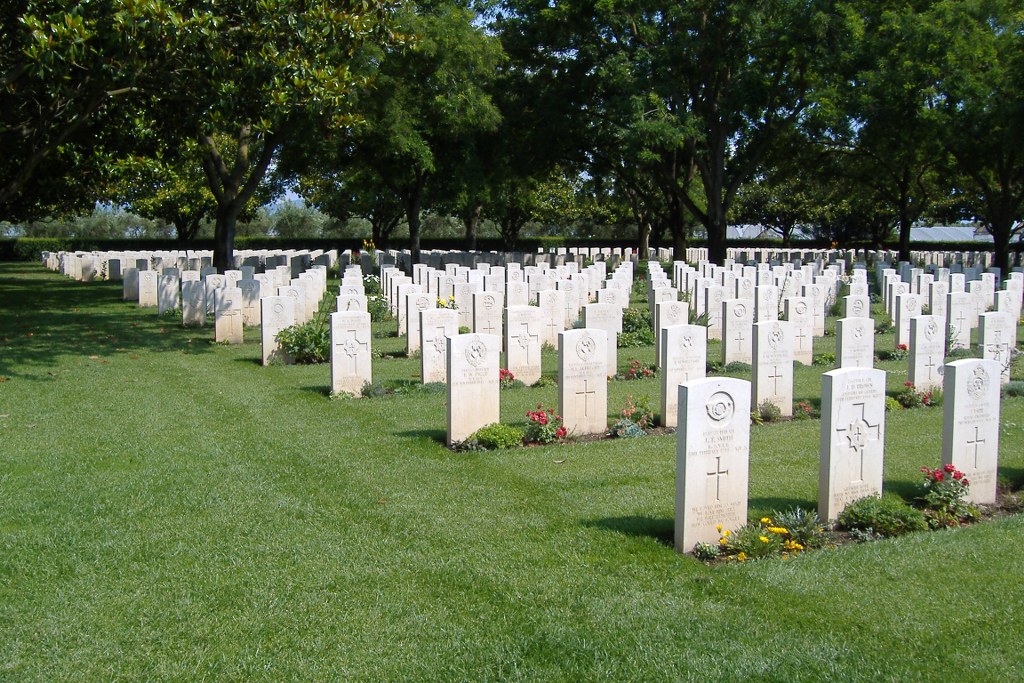Minturno War Cemetery
- Country Italy
- Total identified casualties 1954 Find these casualties
- Identified casualties from Second World War
- GPS Coordinates Latitude: 41.24304, Longitude: 13.76641


SHARE STORIES OF THE ITALIAN CAMPAIGN
If you'd like to know more about who we commemorate, visit For Evermore: Stories of the Fallen, the CWGC online commemorative resource. Here you can read and share the fascinating stories from some of the people who took part in the Italian Campaign.
Location information
Minturno is about 78 kilometres north of Naples, close to the coast. The cemetery lies several kilometres south of the town on the SS7 road to Naples and is situated in the locality of Marina di Minturno (Garigliano). To reach the cemetery take the Cassino exit from the A1 motorway, then turn right to follow Ausonia, Formia, Minturno. At about 30 km the road runs tangientially to a flyover. Go under the flyover, turn left and take the SS7 Appia road towards Scauri and Naples. Go over Scauri and then, after 4 kilometres, to Marina di Minturno and the cemetery is a further 3 kilometres, on the right hand side.
Cemetery address: Minturno War Cemetery, Strada Statale 7, 04026 Minturno (LT).
GPS Co-ordinates:
Back entrance gate to cemetery; Latitude: 41.240844, Longitude: 13.765905.
Visiting information
PARKING
Parking is in front of the main entrance in a semi-circular, flat, gravel area.
The parking area marked by bollards.
There are no other on street or off-street parking areas nearby.
ACCESS, LAYOUT AND MAIN ENTRANCE
The cemetery is rectangular shaped and approached by a long, flat, wide grass aisle lined with trees. To the right-hand side of the aisle is the gardener’s cottage.
The entrance to the cemetery area is at the end of the long tree lined aisle, approximately 200 m from the car park. There are two brick columns topped with the Lion and Unicorn. These mark the entrance into the cemetery. There are two double gates – each adjacent to the entrance columns; each gate section approximately 700 mm wide, and a step up from the parking area.
The main route to the cemetery along the grass aisle is firm and flat, shade offered in the summer months by leafy trees lining the route.
The internal paths are flat and grass. There is seating with stone benches built into the wall, next to the small shelter building on the left side of the paved entrance area in front of the Stone of Remembrance. The Cross of Sacrifice is located behind the Stone of Remembrance at the rear of the cemetery.
The Register Box is located inside the small shelter building at the paved entrance to the cemetery.
There is a large stone shelter building on the right of the cemetery close to the service entrance, with seating along the outside front wall and inside the building.
ALTERNATIVE ACCESS
There is alternative access via a service entrance on the far side of the cemetery from a small track road off Via Virilassi, which is accessible from Via Pantano approximately 300 m west from the parking area in front of the entrance (approximately a 1 km drive)
There is a barrier gate at the service entrance, locked outside working hours.
ADDITIONAL INFORMATION
Minturno War Cemetery is permanently open.
History information
On 3 September 1943 the Allies invaded the Italian mainland, the invasion coinciding with an armistice made with the Italians who then re-entered the war on the Allied side. Allied objectives were to draw German troops from the Russian front and more particularly from France, where an offensive was planned for the following year.
Progress through southern Italy was rapid despite stiff resistance, but by the end of October, the Allies were facing the German winter defensive position known as the Gustav Line, which stretched from the river Garigliano in the west to the Sangro in the east. Initial attempts to breach the western end of the line were unsuccessful and it was not until 17 January 1944 that the Garigliano was crossed, and Minturno taken two days later.
The site for the cemetery was chosen in January 1944, but the Allies then lost some ground and the site came under German small-arms fire. The cemetery could not be used again until May 1944 when the Allies launched their final advance on Rome and the US 85th and 88th Divisions were in this sector. The burials are mainly those of the heavy casualties incurred in crossing the Garigliano in January.
Minturno War Cemetery contains 2,049 Commonwealth burials of the Second World War.
The cemetery was designed by Louis de Soissons.



